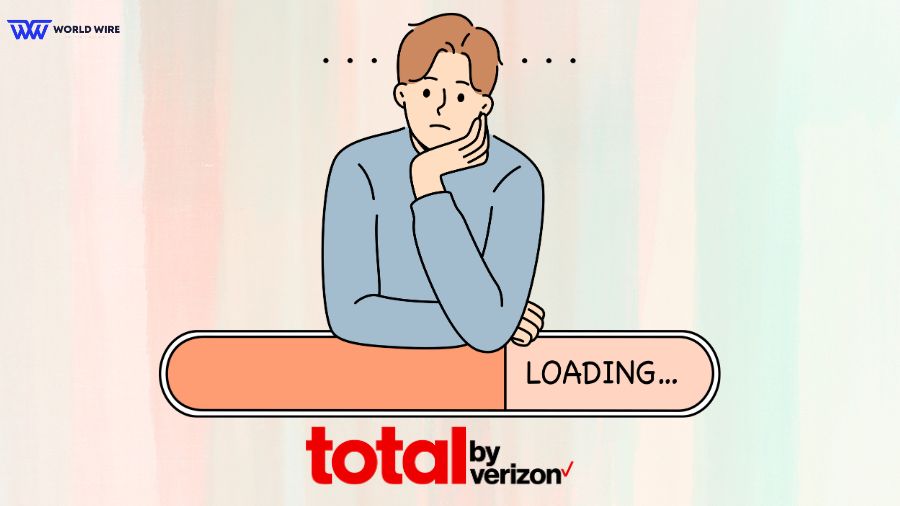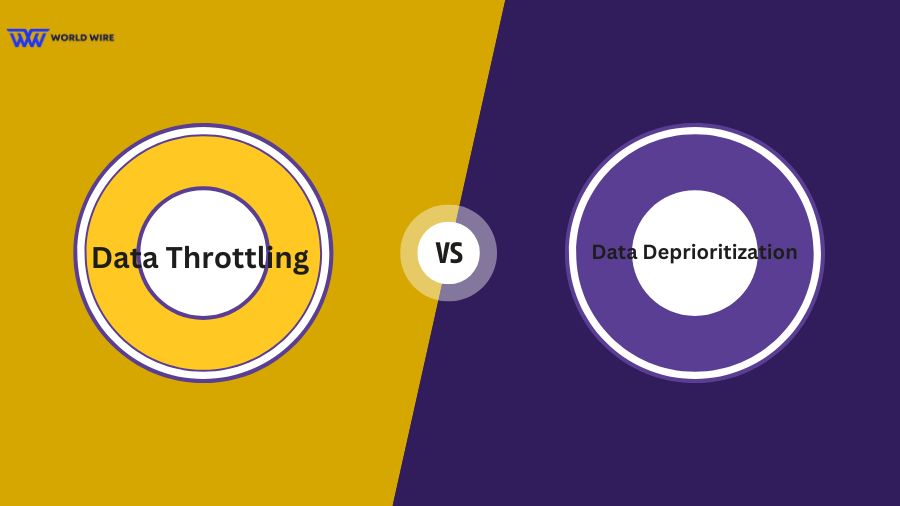Do you want to know what Total Wireless Deprioritization is and how you can fix it? If so, then you have stumbled upon the right article.
Total Wireless offers the best values as a wireless provider and fantastic coverage on Verizon’s network at a fraction of the price, which is useful for budget-minded users who prioritize saving money.
But there is a downside. You can encounter slower data speeds during times of congestion.
This is due to a concept called data deprioritization, and it is important to understand how it impacts your experience as a Total Wireless user.
To understand it clearly, imagine you (a Total Wireless customer) and your friend (a Verizon customer) are at a sporting event with many people using their phones.
Both you and your friend are trying to upload photos to your respective social media accounts.
Your friend might be able to upload the pictures quickly, while your upload speed might be slower because of deprioritization despite being on the same network (Verizon).
In this article, I have shared everything I know about Total Wireless Deprioritization and how you can manage it.
So, without any further ado, let’s get started.
What Is Total Wireless Deprioritization?

Total by Verizon, or Total Wireless, is a mobile virtual network operator (MVNO) that uses Verizon’s network to provide prepaid wireless services in the United States.
Verizon is one of the largest network operators known to offer the most reliable and fastest 4G-5G services.
This means total wireless customers use one of the country’s most trusted networks. However, Total Wireless customers experience data deprioritization over Verizon’s direct subscribers.
So, what actually is Total Wireless deprioritization?
The word deprioritize means lowering the level of priority for one in comparison to another.
In the world of wireless networks, deprioritization occurs when the network you are using gives priority to other users during peak hours, slowing down your data speeds.
Simply put, Total Wireless customers are prioritized less over Verizon during congestion or peak usage time.
Being an MVNO, Total Wireless leases a network from Verizon, which operates its network.
During rush hours or in crowded places, Verizon prioritizes its customers over Total Wireless, which causes Total’s customers to experience low data speeds.
This means that at times of heavy network congestion, Total Wireless customers experience slower data speeds than Verizon customers would in the same area.
It is important to note that deprioritization does not mean you experience unusable data speeds. It means that data speed for Total Wireless customers might be slower than a Verizon customer on the same network at a busy time.
Also, the extent of deprioritization can vary depending on location and network congestion.
Data Deprioritization Impact On Total Wireless Users

Data deprioritization can be a minor issue for people who mainly use their phones for basic tasks like texting, calling, or browsing.
However, it can impact those who rely on their phone data for work or entertainment and require high-speed data for online gaming or streaming.
Data deprioritization primarily impacts data speed for Total Wireless customers.
During peak usage times or crowded areas with many users on the network,
Total Wireless customers experience slower downloads, uploads, and overall internet browsing during network outages or if they have used all of their data allotment.
This can affect their activities like streaming music or videos, downloading large files, and using real-time apps like video chat or online gaming.
The impact of deprioritization can vary for different areas.
Living in a busy city or crowded area makes you more likely to experience data slowdowns because total wireless customers in less congested areas experience less deprioritization.
Similarly, If you have signed up for a limited allotment data plan, you will face Total Wireless Deprioritization.
How To Manage Total Wireless Deprioritization?

Managing Total Wireless deprioritization is difficult since it is built into the network management system. However, you can use some tips to reduce its impact.
Be Aware of Peak Usage Times
Total Wireless deprioritization is higher during congestion, which is more likely during peak hours like lunchtime or evenings.
You can try to schedule data-intensive tasks like downloading files or streaming videos for off-peak times, such as early morning or midnight.
Track Your Data Usage
Tracking your data means monitoring how much internet data you use on your phone or other devices.
This is important because using too much data might slow your internet, especially with services like Total Wireless.
You can keep track of your data usage through the Total Wireless app or your phone settings.
Use Wi-Fi Whenever Possible
You can use Wi-Fi for data-intensive activities whenever you have access to it. This will take the load off the cellular data and help you avoid the impact of slowdowns due to deprioritization.
Consider Location
If you live in a rural area with less network congestion, deprioritization might not be a significant issue. However, it has more impact in crowded urban areas.
You can move to a less crowded location when you need to do important tasks with your cellular data.
Upgrade Your Plan
If possible, upgrade to a higher-tire Total Wireless plan, which offers truly unlimited data, as it might offer some improvement. Total Wireless unlimited data plans start at $50/line per month.
Make sure the unlimited data plan you choose doesn’t have a data deprioritization.
Switch Carriers
Last but not least, if you live in a much-crowded area where Total Wireless deprioritization is a major issue, and if consistent high speeds are a much-needed aspect, you can consider switching to a plan directly from Verizon or another major carrier.
These plans generally don’t experience deprioritization. However, you should also consider the monthly costs and your plan budget.
Also, before you move out, make sure to unlock your Total Wireless device.
By using these tips and understanding your data usage patterns, you can smartly manage the impact of deprioritization as a Total Wireless customer.
The Difference Between Data Throttling And Deprioritization

You must have heard about data throttling, which is used interchangeably with data deprioritization. Although both terms seem similar, there is a difference between them.
| Feature | Data Throttling | Data Deprioritization |
| What it means? | Slowing down internet speed on purpose |
Lowering internet speed when the network is busy
|
| When does it happen? | Anytime, based on policy. |
During busy times, like lots of people using the network
|
| Speed | Always slow until the next billing cycle or policy change |
Slow only during busy times, normal otherwise
|
| Control | Set by service provider, not related to network traffic |
Based on current network traffic, not always in control
|
| Who it affects? | Users who exceed data limits or are on specific plans |
Users in busy areas, regardless of data use
|
Data Throttling
Data Throttling is the slowdown of your data speed when you consume a certain amount of data set in your phone plan (data cap).
Once you exceed that limit, your carrier slows down your internet speed. With this speed, things like streaming or downloading become impossible.
You can do basic things like email checking and web browsing, but it is generally insufficient even to do such simple tasks.
This means that in data throttling, your data gets reduced to an unusable speed you can not use for significant activities.
For example, your monthly plan includes 15 GB of data.
Once you have consumed 15 GB of high-speed data in a given month, your data will be throttled to a much slower speed until you add additional data or your next billing cycle begins.
Data Deprioritization
Data deprioritization is the speed reduction during congestion. It is all about managing traffic on the cellular network during busy hours.
It happens when many people use the data network in a certain area, like a crowded stadium, and network providers prioritize their own customers over their MVNO customers.
This can slow your speeds even if you have not exceeded your data cap. Deprioritization is usually temporary, and your speeds return to normal once the congestion eases.
Frequently Asked Questions
Is Total Wireless a good carrier?
Whether Total Wireless is a good carrier depends on your needs and budget. If you are a light data user and deprioritization is not a major concern, Total Wireless can be a good option for its affordability.
But if you rely heavily on mobile data for your important activities and need consistent speeds, you may look for another carrier’s plan that offers prioritized data.
Is deprioritization and data throttling the same?
No, deprioritization and data throttling are not the same, although they both affect your cellular data speed.
Deprioritization occurs during high network congestion when a carrier prioritizes its own customers over customers of another carrier using its network.
Data throttling occurs when you reach your data cap for the month. Speed slows down temporarily in deprioritization and remains usable for basic tasks like browsing or email.
In contrast, speed becomes insufficient even for simple tasks in data throttling until the next billing cycle begins or until you purchase additional data.
Is there a way to avoid Total Wireless deprioritization?
There is no guaranteed way to avoid Total Wireless deprioritization, as it is network-inbuilt from the provider’s side.
However, you can reduce deprioritization impacts by using Wi-Fi wherever possible to download large files and carry out data-intensive activities during off-peak times.
When does Total Wireless deprioritization happen?
Deprioritization occurs when there is high traffic on the Verizon network in your area, such as during peak hours, at events with a lot of people using data, or in areas with limited cell tower capacity.
Conclusion
In conclusion, Total Wireless is a budget-friendly option to access Verizon, the country’s most extensive network.
However, it comes with deprioritization issues affecting users in crowded areas.
Although there is no perfect solution to prevent deprioritization except to switch providers, you can reduce its impact by following some helpful tips mentioned in the post.
Total Wireless is a good fit for people who prioritize affordability over data speeds. But if you want high-speed data with consistent performance all the time, you may want to consider plans with prioritized data.
Understanding Total Wireless deprioritization will help you decide whether it meets your data requirements and budget.







Add Comment